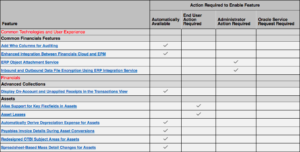
Historically corporate software companies spend thousands building new features for their ERP, HCM, Manufacturing systems and every 3-5 years customers worked on a major upgrade which involves thousands of dollars on multiple areas. This “major upgrade” was either a technology change, new functionality due to the change in the business model or a combination of those. In any case, this upgrade would also cost a few thousands and the cycle would start over again.
Back in 2014, when “SaaS” was at the early stages for Oracle, one of their products (Peoplesoft, now called Applications Unlimited), adopted a very innovative method for the corporate software industry. It was called Continuous Delivery Model (CDM) which for an on premise software was quite futuristic.
Oracle has recently announced, for their Software as a Service (SaaS) and other cloud products, a new “Continuous Delivery model” for its software looking for opportunities that would avoid big investments in future major upgrades. 2014 innovation was definitely the seed for what now has become the driver for stopping the bi-annual upgrades for their Cloud SaaS products and moving into quarterly updates.
Last year, I anticipated the changes in the naming of versions and the new method in a blog entry at the IT Convergence website, and now I want to emphasize the change in the software industry into this new (or old) paradigm. The Cloud vendor leaders are moving towards this trend such as Azure, AWS, and more.
Per Oracle, and every software company, the guiding principles of the Continuous Software Delivery is to let customers to:
 Incrementally adopt new business value.
Incrementally adopt new business value.- Take only the changes they want.
- Determine when the changes are applied.
- Eliminate the need for major upgrades.
Incrementally adopt new business value
It happened to me at multiple organizations, where the announcement of a functionality made us wait from 8-12 month to get that into our ERP with the tough decision of the business asking why don’t we customize now instead of waiting! Now Oracle SaaS users will have a maximum of 3 months to get innovations and new features, so that would be a release for IT leaders and of course the business will be satisfied in a more agile way.
Take only the changes they want.
In the past, every time there was an upgrade, when the decision of executing it was confirmed, we were getting the new features and functionality that was anxiously expected but in most of the cases a bigger number of changes that impacted the upgrade was not even necessary to our organization or business processes and as it was bundled we had no choice to take out that from our testing efforts. Depending on the feature, it would be automatically available, or require an end user action, administrator or even Oracle SR required.
 In other words, you would be able to let the feature “off” until your organization is ready to turn on. Dependencies are calculated so that, in most cases, new features can be applied regardless of the state of the application.
In other words, you would be able to let the feature “off” until your organization is ready to turn on. Dependencies are calculated so that, in most cases, new features can be applied regardless of the state of the application.
Determine when the changes are applied.
Oracle will continue to have the schedule, 1st & 3rd Friday of the month and the administrators will have the choice -they are also working on how to make more efficient this process- of the month, so it fits around the organization’s calendar. For each quarterly upgrade the customers will have the option of choosing which month within the quarter but never going to be more than 3 months from an update.
Eliminate the need for major upgrades.
In the past, major upgrades were traditionally the means to deliver new business features. Now that new features are delivered incrementally, a costly upgrade is unnecessary with the corresponding downtime and negotiation -and inconvenience, with the business.
IT Convergence is a global Oracle consulting and managed services firm that has been focused on Oracle applications for 20 years. We have completed numerous Oracle Cloud implementations, with customers ranging in size from startups to publicly traded companies with revenues in excess of $1B.
For more information on our Cloud applications practice visit our website.
How to get started with Cloud? Let me help you.

By Gustavo Gonzalez, Systems Engineer and MBA, helping companies from multiple industries to shift their business into the digital world, cloud and subscription economy.
